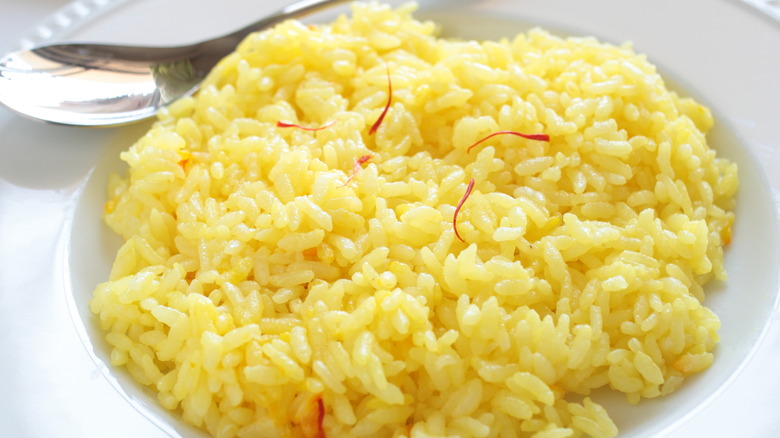What's The Difference Between Spanish Rice And Mexican Rice?
There are a lot of staple grains in the world, but maybe none of them are as universal as rice. Name a continent and rice can be found in abundance, with a wide variety of types of rice available pretty much anywhere you go — brown rice, white rice, basmati rice, even forbidden rice. And because there are so many types of rice under the sun, there are just as many ways to prepare all those types of rice. Enter Mexican rice. Or, wait, is it Spanish rice? Are the two the same thing?
Not at all, it turns out. Rice may have been introduced to Mexico by the Spanish, but "Spanish rice" and "Mexican rice" are vastly different. Their texture isn't the same, they don't have the same ingredients, and they don't even look the same (thanks to the different ingredients). If there's a greatest point of divergence, it comes down to which spice is the star of each dish: saffron or cumin.
Spanish rice has saffron while Mexican rice has cumin
Spanish cuisine makes significant use of saffron, one of the most expensive spices on the planet. Saffron shows up all over the place in Spanish food, and it's the star of what is perhaps Spain's most well-known rice dish: seafood paella. Much like Spanish rice, paella is a rice-based dish enriched with saffron. But while paella is a cohesive dish featuring other ingredients like mussels, shrimp, chorizo, and vegetables, Spanish rice is much simpler: At its core, it's mostly rice and saffron with few other aromatics, allowing the saffron to be the star. It can technically be said that paella consists of Spanish rice and other things, though — which gets at Spanish rice's strength as a building block for other dishes.
Mexican rice, by contrast, is typically a complex dish all on its own. Also known as arroz rojo (literally "red rice"), Mexican rice is cooked in stock with tomatoes and flavored with cumin — as well as a few other things. This gives it a much earthier taste than its Spanish counterpart, as well as a dramatically different color.
The two neither look nor taste the same
So how do you tell the two apart? Well, color is the first marker. Saffron imparts a very distinctive yellow color when it's used as a flavoring, and Spanish rice is no exception (obviously since paella is known for being yellow). Mexican rice, though, is reddish-brown — hence the name "red rice" — thanks to the addition of cumin and tomato. It's harder to confuse them than it is to tell them apart.
Their textures also vary dramatically. Because of how the two are cooked, Spanish rice tends to stick together while Mexican rice doesn't. Because it's so heavily infused with liquids, Mexican rice also tends to be a lot softer, almost melting in your mouth as you eat it (think of it like a not-as-wet risotto).
There's no wrong answer between Mexican and Spanish rice; which you go for is ultimately a matter of personal preference as both make great sides. Just know the differences in flavor profile, and your dinner will turn out great.


